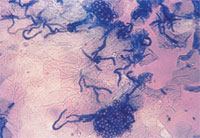|
| Fig. 3.4 A positive cellophane tape preparation of tinea versicolor that has been stained with methylene blue. The characteristic clusters of spores and short hyphae are demonstrated. (Courtesy of James E. Fitzpatrick, MD.) |
Clear cellophane tape preparations are an excellent diagnostic testing material because the organism is found in the upper stratum corneum. First, the skin is scraped to ensure there is adequate scale. The tape is applied over the scale and then mounted on a glass slide and examined under the microscope. Clusters of short hyphae and yeasts are seen producing a “spaghetti and meatballs” pattern. Methylene blue may also be added to the slide, selectively staining the organism and thus enhancing visualization (Fig. 3-4). It is important to note that
Malassezia globosa and
M. furfur, the most common etiologic agents of tinea versicolor, cannot be cultured on any of the routine fungal media kept in most laboratories.
Martin AG, Kobayashi GS: Yeast infections: candidiasis, pityriasis (tinea) versicolor. In Fitzpatrick TB, Eisen AZ, Wolff K, et al, editors:
Dermatology in general medicine, ed 4, New York, 1993, McGraw-Hill, pp 2462–2467.
